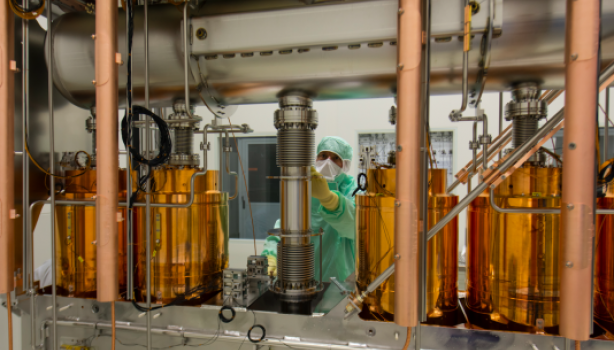The European Vacuum Conference 15 (EVC-15) was successfully organized in Geneva at Centre International de Conférences de Genève (CICG) from 18 to 22 June 2018 by the Swiss Vacuum Society on behalf of the International Union for Vacuum Science, Techniques and Applications (IUVSTA) and with the support of CERN.
This edition gathered 274 registered participants from 31 countries worldwide (72 from Asia, 16 from Americas, 1 from Australia, 5 from Middle East and 180 from Europe). The EVC series was initiated 30 years ago in Salford (UK) by Prof. John Colligon, who briefly traced back its spirit and history during the opening session of this edition in Geneva. As a second birthday event, the EVC-15 had the opportunity to celebrate the 60th anniversary of the foundation of IUVSTA. A dedicated session was held on Monday afternoon with the participation of four eminent invited speakers. Prof. Joe Greene presented a brilliant overview of the developments of materials along the history of mankind and Prof. Anne L’Hullier captured the audience with the fascinating world of attosecond laser pulses and related physics. Dr. Cristoforo Benvenuti presented an exhaustive overview of the possible applications of Non Evaporable Getter (NEG) materials in accelerators and in daily life and finally Prof. Claude Nicollier illustrated his fascinating experience of the impressive constraints when working in space in low earth orbit, as he did in several space-shuttle missions. The session was further extended to an evening event organized by IUVSTA at the CERN Globe of Science and Innovation.
The regular sessions of the conference included 153 oral contributions, including five plenary talks, and two poster sessions. The general theme in EVC conferences includes the technological progress in vacuum generation, measurements and control, as well as the recent advances in other disciplines strongly depending on vacuum, like surface science, nanotechnology at surfaces, thin films deposition and processing of materials for electronic devices. In addition, and in relation with the CERN support to this edition, a special session was dedicated to the applications of vacuum in particle accelerators. Vacuum is presently recognized as a key technology enabling progress in a wide panel of domains [1], from food industry (freeze-dry food) to entertainment devices (flat-panel displays), from the most miniaturized electronics (nanofabrication with synchrotron photolithography) to large particle accelerators, where the ultimate limits of the technology are reached [2].
Throughout the week, many advances were presented and discussed. The capability to tune the optical properties of thin film coatings and produce high efficiency filters with desired transmission fingerprints is nowadays a reality (L. Martinu). This can be achieved by keeping in mind the constraints on mechanical properties for real applications thanks to recent coating techniques (High Intensity and Power Magnetron Sputtering, HIPIMS) enabling a better control of film stresses with excellent hardness properties of the coating. The wide range of applications spans from smart windows for energy saving to solutions against counterfeiting by metameric filters or low noise mirrors for gravitational wave interferometry. The possibilities to prepare thin films of few molecular organic layers and characterize them by scanning probe technique have been illustrated on the example of complex aromatic molecules deposited on a precursor graphene layer. Such films are promising candidates as conducting layers on flexible display panels (OLED) or solar cells (Ch. Teichert). In another approach, high resolution in terms of spectroscopy on 2D materials can be obtained using synchrotron facilities, where the local information on electronic levels, the electronic dispersion relation and the chemistry is well accessible (M. Asensio).
Simulation is a continuously growing domain, and surface evolution at atomic level can be monitored (K. Nordlund). For instance, the effect of ion impact on surfaces for a wide range of energies in terms of structural modifications as well as the ratio of reflected to implanted atoms can be accurately predicted by such methods. Finally, the application of the analysis techniques related to thin films and surface science to masterpieces of art in order to rediscover the technique of ancient paintings and to identify fakes, was convincingly illustrated by Ph. Walter. Among many novelties on instruments, a contribution was dedicated to radiation-resistant gas analyzers aimed to equip long-lasting space missions on far planets, as JUICE. In another case the recent results on the evolution of a hot cathode gauge, which can operate in a wide pressure range and as a He leak detector, were presented. A novel concept of gauge, namely an optical interferometer manometer, to be used in future as primary pressure standard, is also evolving toward the practical realization. It consists in optical cavities, which exploit the gas density dependence of the refractive index and therefore the influence of gas pressure on the optical length. In the domain of vacuum for accelerators, a special session with a wide panel of 16 oral presentations extended from NEG performance at very low thickness, to XFEL intensity tuning based on light absorption by gases. Dynamic pressure during LHC operation, new concepts of NEG preparation, application of shape memory alloys to sealing of vacuum chambers and specific surface treatments by laser or by coatings to mitigate electron cloud phenomena completed this special session.
An industrial exhibition with the participation of 32 firms was held in parallel to the conference, and several talks related to newly developed vacuum instruments were presented by industry participants.
The conference participants had the opportunity to visit CERN during the official excursion, where they could see different facilities such as the vacuum testing laboratory, the cyclo-synchrotron, the Antimatter Decelerator, the magnet mock-up area and the various control rooms. The evening concluded with a well-deserved social dinner at Chateaux de Penthes, where scientific as well as informal discussions were continued.
For further information, please find here the link to the event.
[1] M. Mozetic et al., Recent developments in surface science and engineering, thin films, nanoscience, biomaterials, plasma science, and vacuum technology, Thin solid films 660, 120-160 (2018)
[2] P.Chiggiato, CERN’s prowess in nothingness, CERN Courier edition of 1st June 2018


